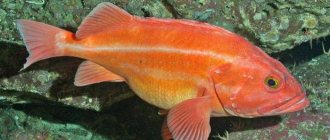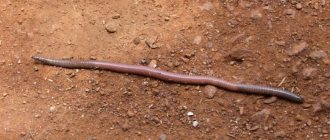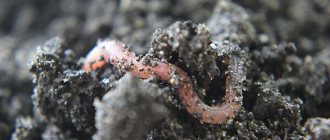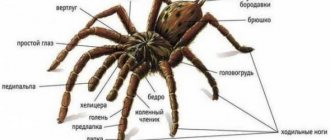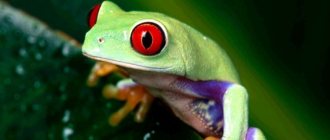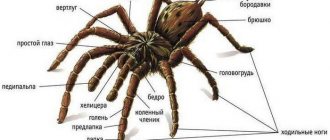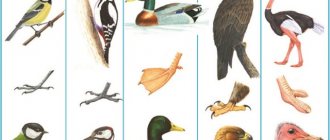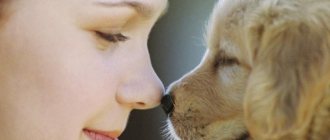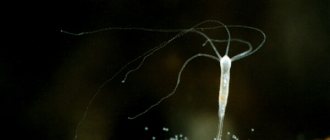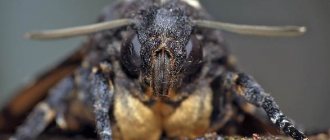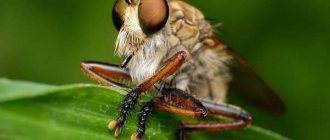External structure
Body
The earthworm, or earthworm (Fig. 51) has an elongated body, 10-16 cm long. In cross section, the body is round, but, unlike roundworms, it is divided into 110-180 segments by annular constrictions. Each segment has 8 small elastic bristles. They are almost invisible, but if we run our fingers from the back end of the worm's body to the front, we will immediately feel them. With these bristles, the worm rests against uneven soil or the walls of the passage when moving.
Regeneration in earthworms is well expressed.
Body wall
If we take a worm in our hands, we will find that its body wall is wet and covered with mucus. This mucus makes it easier for the worm to move through the soil. In addition, only through the moist body wall does the oxygen necessary for breathing penetrate into the worm’s body.
The body wall of an earthworm, like that of all annelids, consists of a thin cuticle, which is secreted by a single-layer epithelium. Under it there is a thin layer of circular muscles, and under the circular muscles there are more powerful longitudinal muscles. By contracting, the circular muscles lengthen the body of the worm, and the longitudinal muscles shorten it. Thanks to the alternating work of these muscles, the worm moves.
General characteristics of annelids
Type annelids. Structure of an earthworm: external structure (ventral view), cross section, circulatory and digestive systems (front end of the worm)
Representatives of the phylum Annelida are the most highly organized worms. They mostly live freely in the seas, fresh water bodies, and soil. About 9 thousand species are known.
The body is elongated, divided into relatively uniform (homonomous) segments ( metameres ), separated by internal partitions, and has a head and sometimes a posterior lobe. Almost every segment has paired organs (nerve ganglia, excretory organs, etc.). In cross section they have a rounded shape. The segments have bristles.
The integument is represented by a skin-muscle sac. Covered with cuticle, which is secreted by the epidermis. There are many mucous glands in the skin. Two layers of muscles: the outer layer is circular and the inner layer is longitudinal. Most polychaete worms develop organs of movement - parapodia . These are mobile muscular outgrowths of the body (primitive limbs), which consist of dorsal and abdominal branches. They can cling to nearby objects.
They have a fluid-filled secondary abdominal cavity ( coelom ), with each segment containing a pair of coelomic sacs (except for the head and posterior lobes), which are located between the intestine and the body wall. The whole differs from the primary cavity in that it is lined with a special epithelium, which, on the one hand, is adjacent to the body wall, and on the other, to the walls of the digestive tube and separates the cavity fluid from the tissues and organs. The lining leaves grow together above and below the intestine and form a mesentery, which divides the coelom into right and left parts. The liquid is in constant motion, thanks to which it transports nutrients, oxygen, carbon dioxide, and gland secretions. Forms a hydrostatic skeleton. The secondary cavity develops in the middle of the mesoderm and is lined with epithelium of mesodermal origin.
Appearance (a) and structural diagram (b) of an earthworm
Habitat
During the day, earthworms stay in the soil, making tunnels in it. If the soil is soft, the worm penetrates it with the front end of its body. At the same time, he first compresses the front end of the body so that it becomes thin, and pushes it forward between the lumps of soil. Then the front end thickens, pushing the soil apart, and the worm pulls up the rear part of the body. In dense soil, the worm can eat its way through the soil through its intestines. Lumps of soil can be seen on the surface of the soil - they are left here by worms. After heavy rain has flooded their passages, the worms are forced to crawl out to the surface of the soil (hence the name - earthworm). In summer, worms stay in the surface layers of the soil, and in winter they dig burrows up to 2 m deep.
| Rice. 51. Earthworm and its movement in the soil. The front end of the earthworm's body from below |
Benefit
When we see a blooming garden, we understand that to some extent it is thanks to earthworms that enrich the soil with nutrients. These creatures process organic matter in the soil, turning it into nutrients that are easily absorbed by plants.
When earthworms dig, they plow the soil at the same time, which allows roots to grow, allowing for healthy plant growth. Tilled soil absorbs water and holds it inside. In addition, air circulates better in such soil. The movements of earthworms bring nutrients found deep in the soil to the surface. Nutrients enter the upper layers of the soil, where they are easier for plants to absorb.
In addition to the benefits that earthworms bring to plants, they also serve as food for birds. In early spring, birds fly to gardens precisely in search of worms, because at this time of year there are still no fruits or seeds that could serve as food for them. If an earthworm is placed in a container that does not allow light to penetrate, it will live in it for about two weeks, provided that peat moss is first placed in the container.
There are millions of earthworms. They are divided depending on their properties and location. They can be divided into: earthworms, red worms, field worms, nightworms and red hybrids. In one garden you can find several varieties of worms.
Earthworms come in a variety of colors and sizes. Their color is characterized by shades of gray, black, red or red-brown. Their length, as a rule, is 5 - 31 cm. And in some cases you can find worms of incredible length of about 370 cm, such as individuals living in Australia. Moist soil rich in nutrient-rich organic matter is ideal for worms.
Earthworms feed on insects, rotting animal carcasses, manure, lettuce and watermelon rinds. In most cases, earthworms avoid alkaline and acidic substances. However, their food preferences depend on their species. Nightworms, as their name suggests, scavenge for food from the surface after dark.
the remains of herbs and organic matter make up the diet of the worms. Having discovered food, they begin to dig in the ground, holding the food they find in their mouths. Worms really like to combine food with soil. Many earthworms, such as red worms, crawl to the surface of the soil in search of food.
Gardeners can help earthworms thrive by adding organic matter to the soil. When the organic content of the soil decreases, earthworms go in search of other soil with more favorable conditions, otherwise they will simply die. Proteins from the remains of worms are converted into nitrogen and feed plants. However, this benefit is very short-lived. The death of earthworms implies a deterioration in the condition of the garden, such an important role they play in nourishing the soil.
Earthworm or earthworm. schizoform
Digestive system
The mouth is located at the anterior end of the earthworm's body; the anus is on the back.
The earthworm feeds on rotting plant debris, which it swallows along with the soil. It can also drag fallen leaves from the surface. Food is swallowed as a result of contraction of the muscles of the pharynx. The food then enters the intestines. Undigested remains, along with soil, are expelled through the anus at the rear end of the body.
The intestines are surrounded by a network of blood capillaries, which ensures the absorption of nutrients into the blood.
| Rice. 52. Internal structure of an earthworm. Digestive, nervous, circulatory system of an earthworm |
The meaning of annelids
Annelids are an important link in the food chain. Many species form the food supply for fish (for example, Nereis). From the Sea of Azov, Nereis was moved to the Caspian Sea in order to maintain the food supply of valuable industrial fish species.
Earthworms are soil formers; they improve the properties of the soil, enrich it with oxygen and organic matter, make it loose, facilitate the access of moisture, and mix the soil layers. Through the digestive system, the earthworm passes as much soil as its body weighs (approximately 4 - 5 g). Abroad (in Japan, America, etc.) earthworm cultures are bred to obtain soils, and various plants (vegetables, herbs, etc.) are grown on them. The importance of earthworms as soil formers was noted by Charles Darwin.
Some types of annelids are eaten by humans (palolo) and used as live bait in fishing (sandfish, etc.). The annelid tubifex is used as food for aquarium fish.
Medical leeches are used for hypertension (high blood pressure), to reduce blood clotting and resolve blood clots. To do this, leeches are caught or specially bred. The substance hirudin is obtained, which is used in medicine and the perfume industry.
Circulatory system
All secondary cavities have a circulatory system, starting with annelids. Its occurrence is associated with a mobile lifestyle (compared to flat and protocavitary worms). The muscles of annelids work more actively and therefore require more nutrients and oxygen, which the blood brings them.
The earthworm (Fig. 52) has two main blood vessels: the dorsal, through which blood moves from the rear end of the body to the front, and the abdominal, through which blood flows in the opposite direction. Both vessels in each segment are connected by ring vessels.
Several thick annular vessels are muscular; due to their contraction, blood moves. Muscular vessels (“hearts”) located in segments 7–11 push blood into the abdominal vessel. In the “hearts” and spinal vessels, valves prevent blood from flowing back. From the main vessels, thinner ones depart, which then branch into the smallest capillaries. These capillaries receive oxygen through the surface of the body and nutrients from the intestines. From the capillaries that branch in the muscles, carbon dioxide and decay products are released. Blood moves all the time through the vessels and does not mix with the cavity fluid. Such a circulatory system is called closed. Blood contains hemoglobin, which is able to carry more oxygen; she is reddish.
A closed circulatory system allows you to significantly increase your metabolic rate. In annelids it is twice as high as in flatworms, which do not have a blood pumping system.
Transporting oxygen cells
Oxygen cells in vertebrates carry hemoglobin from the respiratory organs. In the blood of earthworms, a substance similar in composition also brings oxygen to all cells of the body. The only difference is that worms do not have respiratory organs. They “inhale” and “exhale” through the surface of the body.
The thin protective film (cuticle) and epithelium of the worm's skin, together with the large capillary network of the skin, guarantee good absorption of oxygen from the air. The capillary web is so large that it is even found in the epithelium. From here, the blood moves through the wall vessels of the body and the transverse vessels into the main stem channels, due to which the entire body is enriched with oxygen. The reddish tint of the body of this ringed species is given precisely by the large capillary network of the walls.
Here you need to take into account that the thin film covering the earthworm’s body (cuticle) is very easily moistened. Therefore, oxygen first dissolves in water droplets, which are held by the skin epithelium. It follows from this that the skin should always be moisturized. Thus, it becomes clear that environmental humidity is one of the important conditions for the life of these animals.
Even the slightest drying of the skin stops breathing. Because the earthworm's circulatory system does not bring oxygen to the cells. It cannot survive in such conditions for very long, using internal water reserves. The glands located in the skin help out. When the situation becomes really acute, the earthworm begins to utilize the cavity fluid, spraying it in parts from the pores located on the back.
Excretory system
The excretory system of an earthworm consists of paired tubes in each body segment (with the exception of the terminal ones) (Fig. 53).
At the end of each tube there is a funnel that opens as a whole, through which the final waste products (represented mainly by ammonia) are discharged out.
| Rice. 53. The structure of an earthworm in longitudinal and transverse sections. Paired tubules of the excretory system are visible |
Earthworm nutrition
This is a spineless omnivore. Earthworm organs
are designed so that they can swallow huge amounts of soil. Along with this, rotten leaves are used, everything except hard ones that smell unpleasant to the worm, as well as fresh plants.
The figure shows the structure of an earthworm
They drag all this food underground and begin to eat there. They do not like the leaf veins; the worms only eat the soft part of the leaf. It is known that earthworms are thrifty creatures.
They store leaves in their burrows as reserves, neatly folding them. Moreover, they may have a special hole dug for storing provisions. They fill the hole with food and cover it with a lump of earth. They do not visit their storage until necessary.
Reproduction and development
Earthworms are hermaphrodites. During the process of copulation of two individuals, mutual fertilization occurs, that is, the exchange of male gametes, after which the partners separate.
The ovaries and testes are located in different segments at the anterior end of the body. The location of the reproductive organ system is shown in Figure 51. After copulation, a belt is formed around each worm - a dense tube that secretes the cocoon shell. The cocoon receives nutrients that the embryos will subsequently feed on. As a result of the expansion of the rings located behind the cocoon, it is pushed forward towards the head end. At this time, 10-12 eggs are laid through the opening of the oviduct into the cocoon. Further, when the cocoon moves, sperm from the sperm receptacles received from another individual during copulation enters it, and fertilization occurs. After this, the cocoon slides off the worm and its holes quickly close. This prevents the eggs it contains from drying out.
The development of earthworms is direct, that is, they do not have larvae; a young worm hatches from the egg.
Character and lifestyle of the earthworm
Most of the life of these spineless creatures is spent underground. Why earthworms
are they most often found there? This keeps them safe. Networks of corridors at various depths are dug underground by these creatures.
They have a whole underground kingdom there. Mucus helps them move even in the hardest soils. They cannot be under the sun for a long time; for them it is like death because they have a very thin layer of skin.
Ultraviolet radiation poses a real danger to them, so the worms are mostly underground and only crawl to the surface in rainy, cloudy weather.
Worms prefer to be nocturnal. It is at night that you can find large numbers of them on the surface of the earth. Originally earthworms in the soil
They leave part of their body in order to reconnoiter the situation and only after the surrounding space has not frightened them in any way do they gradually go outside in order to get food for themselves.
Their body can stretch perfectly. A large number of the worm's bristles curve back, which protects it from external factors. It is almost impossible to pull out a whole worm without tearing it because, for the purpose of self-defense, it clings to the walls of the burrow with its bristles.
Earthworms sometimes reach quite large sizes
It has already been said that the role of earthworms
for people it is simply incredible. They not only improve the soil and fill it with useful substances, but also loosen it, and this helps saturate the soil with oxygen. In winter, in order to survive in the cold, they have to go deeper so as not to experience frost and hibernate.
They sense the arrival of spring by the warmed soil and rainwater that begins to circulate in their burrows. With the arrival of spring, the earthworm crawls out
and begins his labor agrotechnical activities.
Position in taxonomy (classification)
Earthworms belong to the phylum Annelids, the class Beltworms, and the subclass Oligochaetes.
On this page there is material on the following topics:
Download earthworm description and structure
Body wall of all worms
Earthworm Report
Create an essay on a small earthworm
Earthworm body shape description
Questions about this material:
What does the body wall of an earthworm consist of?
What functions does blood perform in an earthworm?
Why does an earthworm develop a circulatory system?
How do the end products of earthworm excretion occur?
How does the nervous system of an earthworm work?
Whose sperm fertilizes the eggs of a hermaphroditic earthworm?
Create a food network where the earthworm can enter.
Variety of annelids
Type annelids: class Polychaetes or Polychaetes, class Oligochaetes or Oligochaetes and class Leeches
Class Polychaete worms or Polychaeta
Class Polychaetes or Polychaeta: Amphitrite, Sea Mouse, Green Nereis, Peskozhil and Serpula
The most common class. There are about 6 thousand species. Dimensions from 1 mm to 3 m. Mainly marine animals, free-living. Only some representatives are parasites. Body shape – elongated, slightly flattened. The head is well developed, the rear part is pronounced. Segments of the body can be either identical in structure and function, or different. The body is covered with single-layer epithelium and various outgrowths (especially the head lobe). It has projections (with two branches: ventral and dorsal) with tufts of setae on the sides of the body for active locomotion ( parapodia ) on each segment. The epithelium may have glandular cells, and in primitive species - cilia. In sessile species, epithelial secretions may harden and form a tube.
Some species have respiratory organs - gills (body outgrowths on parapodia). Others breathe throughout the entire body.
The circulatory system is closed. They have organs of vision and a pair of tentacles (organs of touch). Regeneration is pronounced.
Dioecious animals. Sexual dimorphism is not expressed. Development in polychaetes is indirect. trochophore ) covered with cilia emerges from the egg Some species can reproduce asexually.
Representatives: peskozhil, nereis, Pacific palolo , etc.
Class Oligochaetes or Oligochaetes
Class Oligochaetes or Oligochaetes: Ripistes, Stilaria, Elosoma and Chaetogaster
About 5 thousand species are known. Distributed mainly in fresh water bodies and soil. Sizes vary greatly. There are no parapodia. The head lobe is poorly expressed. Hermaphrodites. Fertilization is internal. Development is direct. The eggs are laid in a cocoon. Asexual reproduction occurs by fragmentation. Representatives: tubifex, earthworm , etc.
Earthworm (Lumbricus terrestris)
Earthworm: appearance, internal structure, cross section, pattern of movement of the worm in the soil, reproduction, mating of two individuals, exchange of sexual products. Earthworms in summer and worms overwintering in deep burrows
Dimensions reach 15 – 30 cm. Lives in the soil. Forms soil and increases its fertility. Feeds on plant remains. The body is elongated, consists of segments, the number of which is 140 - 180. Near the 31st segment there is a special formation - the girdle. This is an organ that secretes a substance from which a cocoon is built, two individuals stick together during mating. Each segment has four pairs of setae (remnants of parapodia). The skin is covered with mucus secreted by the cutaneous glands. The integument is represented by a skin-muscular sac, which consists of four layers: mucous cuticular lining, epithelial cells, muscle layer, and thin film. The muscles are represented by two layers of muscle fibers: annular septa. The body cavity is lined with epithelium and separated by septa. Filled with liquid, which acts as a hydrostatic skeleton.
Digestive system of an earthworm
The oral opening at the anterior end of the body (head lobe) leads into the thick-walled pharynx, which is located in the first 6 segments. The pharynx passes into a narrow esophagus, into which special limestone glands open, which neutralize humic acids (from the soil). Behind the esophagus there is a crop, which passes into the muscular stomach (the ectodermal section ends). Then the food passes into the mid and hind intestines, which end in the anus - on the posterior segment.
Excretory system of an earthworm
The excretory system is represented by metanephridia. The openings of the metanephridia are located on the dorsal side. They open and close. Not noticeable to the naked eye.
Earthworm circulatory system
The circulatory system is closed and consists of dorsal, abdominal and annular vessels. The six pairs of annular vessels that surround the esophagus and connect the dorsal and abdominal vessels are called the hearts. Their walls, like the walls of the spinal vessel, pulsate. The blood is red and contains hemoglobin in the plasma. It flows in the dorsal vessel to the head end, in the abdominal - in the opposite direction.
Respiratory system of an earthworm
There is no respiratory system. They breathe through the entire surface of the body, so a large number of capillaries branch in it.
Nervous system of an earthworm
The nervous system is represented by the peripharyngeal nerve ring and the ventral nerve cord.
Sense organs of an earthworm
Sense organs: photosensitive, tactile, chemical sensation cells. Light-sensitive cells are located on the head blade.
Reproductive system of an earthworm
Reproduction is only sexual. On the ventral side, on the 14th segment, there is a pair of small round female genital openings. On the 15th segment there is a pair of male genital openings in the form of transverse slits. Hermaphrodites. The gonads are located at the level of 9 – 15 segments. Fertilization is predominantly cross-fertilization. During reproduction, two individuals exchange seminal fluid, which is stored in the seminal receptacles. The secretions of the girdle form a kind of mucous muff. The worm crawls out of the coupling with its back end first. The edges of the coupling stick together and form a cocoon. The eggs are laid in a cocoon (the egg and sperm are released from the seminal receptacle). The cocoon lies in the ground. Young individuals develop from eggs. Development is direct. Such complex reproduction is due to the habitat and the low opportunity to meet a sexual partner.
Earthworms are capable of regeneration.
Class Leeches (Hirudinea)
Leech class (Hirudinea): False-cone leech and Medicinal leech
About 500 species are known. Dimensions - from 1 to 20 cm. They live in the seas and fresh water bodies, sometimes found on land. They come from oligochaete worms. The body is flattened. Setae and parapodia are absent. Predators and bloodsuckers, free-living and parasites (mainly ectoparasites). The outside of the body is covered with a dense cuticle. The head lobe is not expressed. They have two suckers (the front one with the mouth opening and the back one). May have chitinous teeth in the throat for cutting through the skin of the victim. Some species have a long proboscis, which is used to attack prey. The body cavity is reduced and turned into a system of lacunae (sinusoids). The space between the internal organs is filled with parenchyma.
The digestive system is well developed. In bloodsuckers, the salivary glands produce a substance that prevents blood clotting ( hirudin ). The midgut forms lateral protrusions in which blood is stored. Metanephridia are located in only a few segments.
The circulatory system is reduced due to the parasitic lifestyle. It is represented by a system of individual lateral sinusoids (remnants of the body cavity).
The function of blood is performed by coelomic fluid. The blood is colorless or red (has hemoglobin).
Hermaphrodites. Lose the ability to regenerate. Fertilization is internal. Direct development is characteristic.
Representatives: medical leech, horse leech , etc.
Moving on hard ground
In dense soil, the worm also moves with the help of muscles and bristles. At the same time, he swallows the earth with his mouth. Soil particles move through the animal's intestinal tract and nutrients are absorbed from it. Earthworms are detritivores.
Worms have no teeth. The throat sucks in the earth like an enema. The processed soil is pushed out of the anus. On the surface of the earth, on garden and park paths, you can see chains of small balls - coprolites - this is the waste of the worm's digestion. Moreover, in one day one earthworm is able to pass through its insides an amount of soil equal to its weight.
Important! Earthworms are the most important humus-forming creatures on Earth. During the digestion process, compounds of humic acids with inorganic substances (phosphorus, nitrogen, potassium) with low acidity are obtained. Thus, they saturate the soil with substances necessary for the growth and development of plants.
The role of the longitudinal and oblongata muscles
The movement of the raincoat occurs due to contractions of the muscles of its skin-muscular sac. Those. when individual parts of its body shorten and thicken due to muscle contraction.
When the worm moves with effort or is drilled, these parts of its body stretch in length and at the same time become thinner. This work is carried out with the help of other muscles - ring ones, which surround its body and are located directly under the skin. Thanks to the contraction of these muscles, the body in this place becomes thinner, forcing it to stretch longitudinally.
Thus, the movement of earthworms is achieved due to the alternating contraction of the annular and longitudinal muscles, and thanks to the bristles, they can rest and catch on any irregularities.
Variety of type representatives
Appearance of annelids: A – nereid; B - earthworms at the time of insemination; B - leech; 1 - suction cups; 2 - parapodia; 3 - body segments.
Oligochaetes
Oligochaetes are inhabitants of the soil (earthworm) and fresh water bodies (tubifex). They feed on rotting remains, which they ingest in the soil. There are no parapodia. The setae extend directly from the body wall. The head lobe is poorly expressed. The reproductive system is located in several segments of the anterior part of the body. Hermaphrodites. Insemination is internal, cross. Development is direct and occurs in the cocoon, which is formed after fertilization.
Read: Gymnosperms as higher seed plants #11
Polychaetes
Polychaetes are marine animals, often predators (nereid, sandworm, palolo). Each body segment bears a pair of parapodia. The head lobe, on which the sensory organs are located, is well developed. The blood is often red. Dioecious, external insemination (occurs in water), development with metamorphosis (trochophore larva).
Read: Ferns, horsetails and mosses as some of the first land plants #10
Leeches
Leeches are free-living predators or ectoparasites of vertebrate and invertebrate animals that feed on blood. Parapodia and setae are absent. The outside of the body is covered with a dense cuticle. External annulation does not correspond to internal segmentation. There are suckers on the anterior and posterior ends of the body. The cephalic and anal lobes are not pronounced. The body cavity is reduced. The oral cavity has chitinous teeth that cut the skin of the victim when the leech feeds. Saliva contains hirudin, a substance that thins the blood (prevents blood clotting and the formation of blood clots) and promotes the resorption of hematomas. The midgut forms pouches that fill with blood when feeding. Metanephridia are found in only a few segments. Leeches are hermaphrodites. Insemination is internal. Development is direct.
Information sources
1. Biology for applicants. Authors: Davydov V.V. , Butvilovsky V.E. , Rachkovskaya I.V., Zayats R.G.
Reproduction of flatworms
Different classes of flatworms have their own reproductive characteristics. Division can be asexual or sexual.
Reproduction of the class Turbellaria
They divide both sexually and asexually. Asexually, planarians divide into two parts using transverse fission. The newly formed individuals then regenerate on their own to form a full-fledged organism. Sexual reproduction is possible due to the presence of female and male reproductive organs in one individual (hermaphroditism).
The testes produce sperm, which, moving along the vas deferens, are collected in the seminal sacs. The ovaries are located laterally on both sides. The formed eggs leave the ovaries and end up in the seminal receptacle, where the sex gametes are combined.
Reproduction of the Flukes class
Representatives of the class mature using several hosts, the last of which are sheep, goats and humans. Adults leave thousands of offspring per day in the host’s body.
To continue formation, the eggs need to be exposed to an aquatic environment. From the eggs, miracidia develop, which, thanks to the beating of the cilia, easily move in the water. The larva then penetrates the snail's body, where it transforms into a sporocyst. The redia emerge from the sporocyst and develop into cercariae.
This stage of development is dangerous for humans; the worms have formed two suckers, which are attached to the intestinal wall, begin to grow and produce eggs again.
Reproductive system of flatworms
Reproduction of the class Tapeworms
The development of tapeworms is also associated with alternating changes in hosts. Animals are an intermediate environment for their formation; maturation will be completed in the human body.
A person excretes mature segments with feces, where thousands of eggs are located. Once on the soil, grass, the eggs are eaten by animals. In the gastrointestinal tract, six-hooked larvae are formed from the eggs, which penetrate the muscle tissue and transform into Finns.
Finns enter the human body by eating poorly thermally processed food. Mature individuals emerge from the finna into the intestinal cavity and are attached to the walls with suction cups and hooks. Segments gradually begin to grow from the head.
More information about the class Tapeworms.
